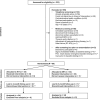Effects of controlled supramaximal high-intensity interval training on muscle capacities and physical functions for older adults: analysis of secondary outcomes from the Umeå HIT study-a randomised controlled trial
- PMID: 39396911
- PMCID: PMC11471315
- DOI: 10.1093/ageing/afae226
Effects of controlled supramaximal high-intensity interval training on muscle capacities and physical functions for older adults: analysis of secondary outcomes from the Umeå HIT study-a randomised controlled trial
Abstract
Objective: This study investigated the effectiveness of supramaximal high-intensity interval training (supramaximal HIT) on muscle capacities and physical function compared to moderate-intensity training (MIT) for older adults.
Methods: Sixty-eight older adults (66-79 years, 56% women), not engaged in regular exercise, were randomised to 3 months of twice-weekly supramaximal HIT (20 minutes including 10 × 6-second intervals) or MIT (40 minutes including 3 × 8-minute intervals). Both groups performed the training on stationary bicycles in a group setting. Target intensity was watt-controlled, with standardised cadence and individualised resistance. Outcomes analysed with linear-mixed models included leg power (Nottingham Power Rig), hand grip strength (Jamar dynamometer), static and dynamic balance (One leg stance, 30-second step test), chair stand (30-second chair stand), and anaerobic cycling performance (modified Borg Cycle Strength Test).
Results: Baseline values were (supramaximal HIT/MIT, mean ± SD) leg power 198 ± 60/189 ± 53 W, hand grip strength 4.2 ± 1.0/4.3 ± 1.1 N/kg, static balance 64 ± 41/62 ± 41 s, dynamic balance 39 ± 7/38 ± 5 steps, chair stands 22 ± 6/22 ± 6 and anaerobic cycling performance 224 ± 60/217 ± 55 W. At 3-month follow-up, a between-group difference in favour of supramaximal HIT [95% CI] was observed in anaerobic cycling performance of 19[3;35] W. Within-group mean changes for supramaximal HIT/MIT were for leg power 8.4[0.9;15.8]/6.0[-1.3;13.3] W, hand grip strength 0.14[0.00;0.27]/0.13[-0.01;0.26] N/kg, static balance 11[3;20]/10[1;18] s, dynamic balance 1.6[0.3;2.8]/2.3[1.1;3.6] steps, 2.1[1.1;3.1]/1.4[0.4;2.3] chair stands and anaerobic cycling performance 31.3[19.6;43.0]/12.0[0.4;23.5] W.
Conclusion: Supramaximal HIT showed superior effect on anaerobic cycling performance when compared to MIT. Additionally, the results indicate that supramaximal HIT is comparably beneficial as MIT in terms of effects on muscle capacity and physical function for older adults.
Keywords: aged; exercise; high-intensity interval training (HIIT); older people; randomised controlled trial; sprint interval training (SIT).
© The Author(s) 2024. Published by Oxford University Press on behalf of the British Geriatrics Society.
Conflict of interest statement
None.
Figures


References
-
- World Health Organization . Ageing and Health in 2020https://www.who.int/news-room/fact-sheets/detail/ageing-and-health (30 October 2023, date last accessed).
-
- Poon ET-C, Wongpipit W, Ho RS-Tet al. . Interval training versus moderate-intensity continuous training for cardiorespiratory fitness improvements in middle-aged and older adults: A systematic review and meta-analysis. J Sports Sci. 2021;39:1996–2005. - PubMed
Publication types
MeSH terms
Grants and funding
LinkOut - more resources
Full Text Sources

